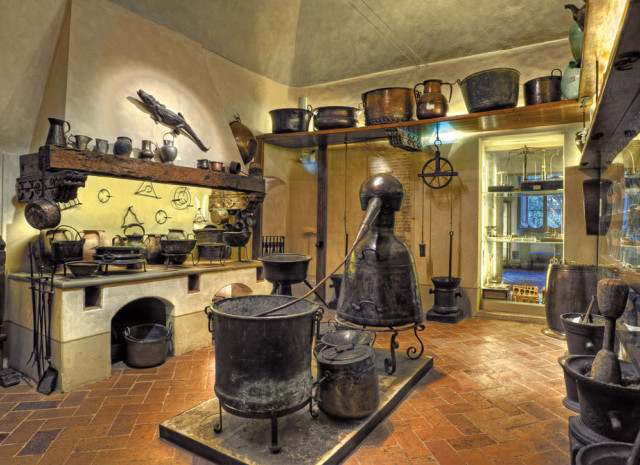





Palazzo Bourbon del Monte, a prestigious Renaissance edifice, is located in the historic centre of Sansepolcro and currently houses the Aboca Museum, featuring two captivating itineraries: “Herbs and Health through the Ages” and the interactive “Aboca Experience”. The former, the only historical tour of its kind, has the ambitious aim of reviving and conveying the millennia-old relationship between humans and medicinal plants by showcasing sources from the past and faithfully recreating the places where herbs were traditionally processed.
The narrative unfolds right at the museum’s entrance, where a showcase displays a summary of the main exhibits present in the museum. It then extends along the staircase, adorned with valuable collections of botanical illustrations sourced from the herbariums preserved in the Museum’s ‘Bibliotheca Antiqua’.
The museum exhibition proper begins on the first floor, encompassing nine rooms displaying valuable herbariums, books on pharmaceutical botany, exquisite ceramics and glassware, all faithfully recreating the historical settings where medicinal plants were processed. Starting in the herb room, visitors then proceed to the 17th-century apothecary’s shop, crossing an 18th-century phyto-chemical laboratory and a poison chamber and ultimately arriving at the perfectly preserved wooden pharmacy from the 1800s. The rooms are all expertly furnished with the instruments and tools used during those centuries to extract medicinal substances from plants.
The visitor is thus accompanied on a fascinating journey into the past, where curiosities, anecdotes and natural scents intertwine to recount the story of herbs over the centuries.
The fourth floor, meanwhile, houses the Bibliotheca Antiqua, one of the world’s most important collections for scholars and researchers in this field. It contains about 2,500 antique printed volumes recounting four centuries of botanical history between the 16th and 19th centuries. These include various types of works, from the earliest treatises on Simples (basic medicinal plants) to studies of Pharmaceutical Botany, and from volumes on Alchemy to Renaissance Pharmacopoeias, including 19th-century compendia of Physics, Chemistry, and Natural Sciences.
Within the Library, there is also a Study Centre, coordinated and directed by a scientific committee composed of international experts in the botanical-pharmaceutical sector. Above the Bibliotheca, there is a medieval tower, a panoramic place from which it is possible to admire the entire town of Sansepolcro.
The Aboca Experience, accessible from the ground floor, offers a multimedia tour that immerses visitors in the world of Aboca. Through interactive installations, visitors can explore the company’s activities comprehensively, including organic cultivation, laboratory and production processes, cultural events, publications and research. This immersive space invites exploration and discovery, shedding light on the importance of biodiversity and the natural resources that the environment provides for our health.
Completing the area on the ground floor of this marvellous venue is the Aboca herbalist shop, where you can purchase all the products of the Aboca – Apoteca Natura group, and the bookshop, where it is possible to consult and purchase the Aboca Edizioni publications and a wide selection of texts related to health and natural well-being.
The history of Palazzo Bourbon del Monte
After the Battle of Anghiari in 1440, Borgo Sansepolcro was ceded by the papal forces for the sum of 25,000 gold ducats to the Republic of Florence, to the great satisfaction of its inhabitants. The town remained under Florentine rule until the Unification of Italy.
In the 1500s, Giuliano da Sangallo, Lorenzo de’ Medici‘s trusted architect, was tasked with the project of fortifying Sansepolcro and designing its new walls. The town was duly embellished with the same walls that are still standing and can be admired to this day. This marked the start of the construction of magnificent palazzos that continue to grace the town’s landscape. Among them is Palazzo Bourbon del Monte, which, following careful restoration, has been home to the Aboca Museum exhibition since 2002.
Characterised by its 17th-century façade and adjoining the Church of San Rocco, the Palazzo is the result of several mergers built on probable medieval constructions, traces of which are preserved in the basement and in the Tower of Catolino, dated between the 12th and 13th centuries and part of the ancient city walls. The building, constructed at the end of the 17th century, was severely damaged by an earthquake in 1703 and changed ownership several times from this period onwards.
Palazzo Bourbon del Monte features a large ballroom that served a dual purpose as a theatre for visiting acting and musical troupes from Biturgia. Adorning this hall is the coat of arms of the Marquises Bourbon del Monte, featuring a blue shield with three golden lilies intersected by a knotted staff. Additionally, as feudal lords, the Marchesi del Monte were granted the privilege of incorporating the double-headed eagle of the Habsburg-Lorraine dynasty, who had succeeded the Medici in governing Tuscany, into their crest.
The Bourbon del Monte family has been closely linked to the history of this town since ancient times. The Marquises acquired the Palazzo at the end of the 17th century from the established Alberti family, and Marquess Monaldo, the twenty-second Regent of the Marquisate, lived there between 1685 and 1757, preferring the milder and more comfortable climate of Sansepolcro over Monte Santa Maria. At the end of the 18th century, this historical residence passed to the Capassini family, then to the Cattanis and finally to the Tricca family.
Palazzo Bourbon del Monte experiences
Palazzo Bourbon del Monte is currently home to the Aboca Museum with its historical tour, “Herbs and Health through the Ages” and its interactive “Aboca Experience”
The ground floor of the museum houses the bookshop with publications from Aboca Edizioni and the Aboca herbalist’s shop, containing Aboca and Apoteca Natura products. Qualified members of staff are happy to advise and answer customers’ requests and requirements.
The Bibliotheca Antiqua is located on the top floor of the museum. It is closed to the public, but can be visited by scholars, researchers and enthusiasts by appointment.
The Museum is equipped with toilets and a lift.
Directly across from the museum, you’ll find the Garden of Piero della Francesca, meticulously tended by the Aboca Museum and featuring a collection of medicinal plants. Adjacent to it is the ‘Il Giardino di Piero‘ restaurant, an Osteria that operates under Aboca’s direct management. Their menu is exclusively crafted from organic ingredients, in perfect alignment with the restaurant’s philosophy.
Places of interest in the nearby
Aboca Museum belongs to the ‘Valtiberina Musei Pass’ museum circuit. By purchasing a ticket for the Museum, visitors are entitled to a reduced ticket price at other museums in Sansepolcro, Anghiari, Caprese Michelangelo, Sestino and Monterchi, and vice versa. Additionally, with the Museum ticket, you also receive a discount at the museums in Città di Castello. The Museum also has agreements with many accommodation facilities in the area, such as hotels and ‘agritourism’ farmhouses.
 Film sets
Film sets
 Pet Friendly
Pet Friendly
 Private events
Private events
 Residences
Residences
 Visits
Visits
 Cultural tourism
Cultural tourism  Historic Homes open to visitors
Historic Homes open to visitors Nessun appartamento configurato per questa dimora o la visualizzazione degli appartamenti non è attiva.